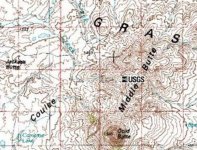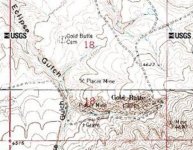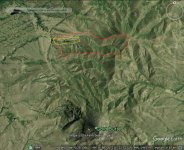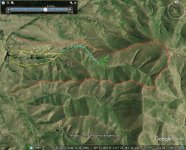

Gold Butte was known for its placer deposits, a man named Rodney Barnes made the discovery here and is said to have taken out around $125,000. All others combined totaled roughly what Barnes recovered. This is a good example that he took the time to find the best piece of ground to stake his legal claim. No one is said to have ever found the source of the gold, in fact a man named Jack Monroe was searching for it as late as 1942!
Missing Mother Lode
Almost all sources tend to agree in every detail about the gold that was discovered at Gold Butte in the Sweet Grass Hills in Toole County. Everyone agrees that the gold was known to the Native Americans living in the region, but they kept it a closely guarded secret for obvious reasons. It wasn’t until 1884 that prospectors named Barnes and Walters who ventured onto land that was considered off limits to whites because it belonged to the Blackfoot Indians discovered gold. Some sources claim the party was made up of 4 members (M. Carey, F. Derwent, G. Walters and J Des Champ). Little could be done at this time because of the treaty and so it wasn’t until the area was ceded back to the Government for settlement that prospectors could venture back in search of gold. But still some staked claims prior to being allowed to legally enter the region and for a time a company of infantry was stationed close by to ensure that order was maintained. Barnes returned with another partner and happened to stake the first claim. There was little water to wash the dirt and the majority of the work was hard and slow going.
A town was founded called Gold Butte of which some interesting old photographs still survived. The old pictures show what appears to be just a couple of dozen wooden buildings in a bleak environment. Still the expectations of making the big strike drew somewhere between 400 to 500 to the area. The area produced gold in all the gulches to the west of Middle Butte with nothing found in the direction of East Butte.
There was an old newspaper called the River Press May 27, 1885 edition, published at Fort Benton I believe that carried a short mention of the gold. The short article stated that sluicing was taking place and all of the course gold had quartz mixed with it. From the sounds of the gold’s description there was a quartz vein somewhere close by. The easy to get gold was basically gone around 1900 and Gold Butte became a ghost town. Years later strip mining was tried in the 1930’s, but that company ran out of money. The lure of gold sparked the interest of yet another company a few years later, but they too packed her in prior to World War II. The source of the gold was never located and is still out there somewhere. Maybe the lure of the missing gold will caused another expenditure of time and money sometime in the future. Almost every book I’ve read that covers Gold Butte claims folks are still poking around in the hills hoping to find a little color, who knows what tomorrow will bring.
Gold Butte Regional Topo Map
This map has Gold Butte basically centered and shows the region surrounding the site of the gold strike. The mother lode from which the gold came was never discovered and might be found some day. One would think that the placer gold came from the higher elevations. This could mean that Middle Butte could hold the hidden vein that has been long sought!
Gold Butte Topo Map 2
The map for this region shows the site of the gold boom town of Gold Butte. Some detail that can be seen by looking at the map are the two placer mines areas and Eclipse Gulch. The cemetery to the north and what appears as a single grave to the south must be desolate places to visit.









